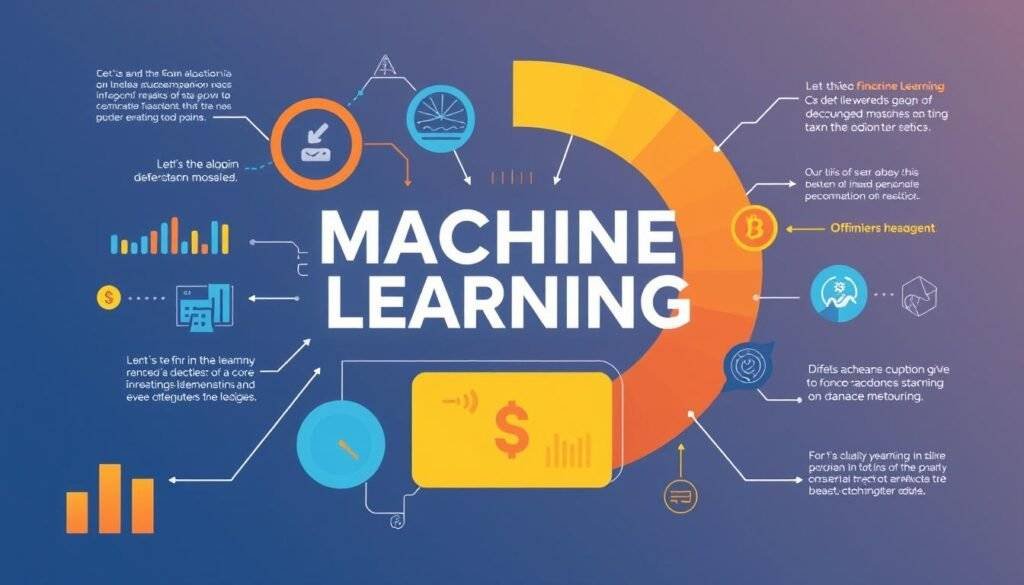The banking industry is undergoing a significant transformation, driven by the adoption of machine learning technologies. According to industry reports, 85% of banks now have a clear strategy for adopting AI and machine learning technologies, recognizing their potential to drive competitive advantage.
We’re seeing a paradigm shift as financial institutions leverage machine learning models to process vast amounts of data, detect patterns, and make more informed decisions. This not only enhances security and efficiency but also improves the customer experience.
As we explore the top machine learning applications in banking, we’ll examine how these technologies are being deployed to address various challenges, from fraud detection to customer service.
Key Takeaways
- The banking sector is adopting machine learning to drive competitive advantage.
- Machine learning models are being used to process vast amounts of data and detect patterns.
- Financial institutions are leveraging machine learning to enhance security and efficiency.
- Machine learning is improving customer experiences in banking.
- The use of machine learning in banking is expected to continue growing.
The Evolution of Machine Learning in the Banking Sector
The integration of machine learning in banking has marked a new era in financial services. As we explore the evolution of this technology, it’s clear that the banking industry has undergone significant changes, driven by advancements in machine learning and data analysis.
From Traditional Banking to AI-Powered Financial Services
Traditionally, banking operations were heavily reliant on manual processes and rule-based systems. However, with the advent of machine learning, these operations have been revolutionized. The banking sector has moved towards advanced machine learning models that can adapt and learn from new data, enabling more accurate decision-making and improved customer experiences.
- The journey of machine learning in banking has transformed from early experimental applications to sophisticated AI-powered financial services.
- The modernization of core legacy systems has removed technological barriers, allowing for the full harnessing of machine learning capabilities.
- Cloud technologies have accelerated the evolution, making machine learning more accessible and cost-effective for banks of all sizes.
The Current State of Machine Learning Adoption in Banking
The current state of machine learning adoption in banking shows that financial institutions are increasingly investing in these technologies to gain competitive advantages. According to the Economist Intelligence Unit’s report, 85% of banks have a clear strategy for adopting AI and machine learning, demonstrating the widespread recognition of these technologies’ value in the banking industry.
As machine learning continues to evolve, its applications in banking are becoming more diverse, from fraud detection to customer personalization. The use of advanced algorithms and data analysis is driving decision-making across various banking functions, further solidifying the role of machine learning in the industry.
Why Financial Institutions Are Embracing Machine Learning
As the financial landscape evolves, institutions are turning to machine learning to stay competitive and achieve substantial economic benefits. The banking sector is on the cusp of a revolution, with machine learning playing a pivotal role in shaping its future.
The potential of machine learning in banking is vast, with McKinsey estimating that generative AI and machine learning could add between USD200 billion to USD340 billion in value for businesses across banking, wholesale, and retail sectors globally. This has led to significant investments in AI, with the financial industry investing an estimated USD35 billion in 2023, of which approximately USD21 billion was accounted for by the banking sector.
Economic Benefits and ROI of ML Implementation
The economic benefits of implementing machine learning are multifaceted. Banks are experiencing a significant return on investment (ROI) through cost reductions, increased efficiency, and new revenue streams. By leveraging machine learning models, financial institutions can process and analyze vast amounts of data to gain deeper insights into customer behavior and market trends.
| Investment Area | Estimated Investment (USD) |
|---|---|
| Financial Industry AI Investment (2023) | 35 billion |
| Banking Sector AI Investment (2023) | 21 billion |
| Potential Value Addition by Generative AI and ML | 200-340 billion |
Competitive Advantages in the Digital Banking Era
In the digital banking era, machine learning provides significant competitive advantages by enabling more personalized customer experiences, faster decision-making, and improved risk assessment. The adoption of machine learning models allows banks to stay ahead of competitors by offering innovative services and responding more quickly to changing customer needs.
By embracing machine learning, financial institutions can enhance their digital banking capabilities, providing customers with more intuitive and responsive banking experiences. This not only improves customer satisfaction but also fosters loyalty and retention.

Fraud Detection and Prevention

With the acceleration of digital payments, banks are turning to machine learning to combat fraud more effectively. The surge in online transactions has created a pressing need for advanced fraud detection systems. According to PwC’s Global Economic Crime and Fraud Survey 2022, 46% of organizations have experienced fraud or economic crimes in the last 24 months, highlighting the critical need for robust fraud prevention mechanisms.
Real-Time Transaction Monitoring
Machine learning algorithms can analyze transaction patterns and customer behavior in real time, identifying suspicious activities that might indicate fraudulent attempts. This capability allows banks to stop fraudulent transactions before they’re completed, significantly reducing financial losses. By leveraging transaction monitoring, banks can now detect and prevent fraud more effectively than traditional rule-based systems.
Anomaly Detection in Banking Operations
Anomaly detection powered by machine learning can identify unusual patterns in banking operations that traditional systems might miss. This is crucial in detecting sophisticated fraud attempts that are becoming increasingly common. By analyzing vast amounts of data, machine learning models can learn to recognize and flag potentially fraudulent activities.
Success Story: Danske Bank’s ML-Driven Fraud Detection System
Danske Bank, one of the largest banks in Denmark, implemented an ML-driven fraud detection system, achieving remarkable results. After switching from a legacy rule-based system, they reduced false positives by 60% and increased fraud detection by 50%. This case study demonstrates the power of machine learning in enhancing fraud detection capabilities and improving overall banking security.
The effectiveness of machine learning in fraud detection lies in its ability to continuously learn and adapt to new fraud patterns. As machine learning models evolve, they become more adept at identifying complex fraud schemes, making them invaluable tools in the fight against financial crime.
Credit Scoring and Loan Underwriting

Advanced machine learning models are redefining creditworthiness assessment in the banking sector. The integration of machine learning in credit scoring is revolutionizing how lenders evaluate potential borrowers.
Beyond Traditional FICO Scores
Traditional FICO scores have been the cornerstone of credit evaluation for decades in the finance industry. However, they have limitations, such as not considering alternative data that could provide a more comprehensive picture of a borrower’s financial behavior. Machine learning algorithms can analyze a broader range of data points, including non-traditional credit history, to assess creditworthiness more accurately.
Expanding Credit Access Through ML Algorithms
One of the significant benefits of using machine learning in credit scoring is the potential to expand credit access to underserved populations. By analyzing a wider array of data, ML algorithms can identify creditworthy individuals who may not have a traditional credit history. This not only benefits lenders by reducing risk but also promotes financial inclusion.
Case Study: 5Point Credit Union’s ML Credit Scoring Model
A notable example of the successful implementation of machine learning in credit scoring is 5Point Credit Union. By partnering with Zest AI to develop a custom ML credit scoring model, they were able to increase their annual profit by $1.5 million. The model’s extensive training on diverse data sets, including FCRA-compliant data from telecom and utility companies, significantly enhanced its accuracy.
Risk Management and Assessment

Risk management in banking is being transformed through the use of advanced machine learning technologies. Financial institutions are leveraging these innovations to enhance their ability to predict and mitigate risks, thereby safeguarding their operations and improving their decision-making processes.
Machine learning models can analyze vast amounts of market data to identify trends and forecast potential risks with greater precision than traditional methods. This capability is crucial for effective risk management and assessment.
Predictive Analytics for Market Risk
Predictive analytics powered by machine learning helps banks assess market risk by identifying patterns and correlations that might indicate upcoming market volatility. By analyzing historical data and real-time market conditions, banks can make more informed decisions and adjust their strategies accordingly.
Companies like Dataminr are using cutting-edge AI technology to collect data and rapidly alert financial institutions about potential risks in real-time. This enables banks to respond promptly to emerging threats and minimize potential losses.
ML-Powered Liquidity Risk Monitoring
ML-powered liquidity risk monitoring allows banks to continuously track and analyze cash flows, funding sources, and market conditions to maintain optimal liquidity levels. This proactive approach to managing liquidity risk is essential for ensuring that banks can meet their financial obligations and maintain stability in the face of market fluctuations.
By leveraging machine learning for risk management and assessment, banks can stay ahead of potential risks and capitalize on new opportunities. The integration of machine learning models into their risk management frameworks enables banks to adopt a more dynamic and responsive approach to managing risk.
Customer Personalization and Experience

Customer personalization is becoming a key differentiator in the banking industry, driven by advancements in machine learning. Today, delivering superior customer experiences is crucial for success in the banking sector. Machine learning provides banks with a deeper understanding of customers’ behaviors, needs, and preferences, enabling them to personalize their offers and increase customer loyalty.
Hyper-Personalized Banking Services
Machine learning algorithms analyze customer data, including transaction history and spending patterns, to create a comprehensive understanding of individual customer needs. This enables banks to deliver hyper-personalized banking services that adapt to each customer’s unique financial situation and goals. For instance, machine learning-based budgeting tools integrated into mobile banking apps can help customers make better financial decisions by identifying user spending patterns and suggesting ways to improve budgeting.
For example, TransUnion bank has partnered with the ML-powered budgeting app Mint to provide customers with personalized tips on improving their credit scores. Such initiatives not only enhance customer experience but also drive loyalty and increase customer lifetime value.
ML-Driven Customer Insights and Engagement
ML-driven customer insights allow banks to anticipate customer needs and proactively offer relevant products and services at the right time. By analyzing customer data, machine learning models can identify patterns that may not be apparent through traditional analysis. This enables banks to engage with customers more effectively, providing them with relevant offers and improving their overall banking experience.
The ability to deliver on customer expectations in real-time through machine learning algorithms creates a more satisfying and frictionless banking experience. As a result, personalization driven by machine learning increases customer engagement, loyalty, and lifetime value for financial institutions.
Chatbots and Virtual Assistants

Machine learning is revolutionizing customer service in banking through the deployment of chatbots and virtual assistants. These AI-powered tools are transforming the way banks interact with their customers, providing 24/7 support and personalized financial guidance. By leveraging natural language processing, a key component of machine learning, chatbots can understand and respond to customer queries in a conversational manner.
24/7 Customer Support Automation
The integration of chatbots in banking has led to significant improvements in customer support. With the ability to operate around the clock, chatbots provide instant responses to customer inquiries, assist in transactions, and offer continuous learning based on interactions. This automation not only enhances customer experience but also reduces wait times and enables support outside traditional banking hours.
Bank of America’s Erica: A Success Story
Bank of America’s virtual assistant, Erica, is a prime example of successful chatbot implementation. Since its launch in 2018, Erica has handled almost one billion interactions, answering over a million unique customer questions. More importantly, Erica provides actionable personalized financial advice, including insights on portfolio performance. This success story highlights the potential of machine learning-powered chatbots in enhancing customer engagement and support.
As machine learning continues to evolve, we can expect chatbots and virtual assistants to become even more sophisticated, offering tailored financial solutions and further enhancing the banking experience.
Document Processing and Management

Document processing in banking is being redefined by advancements in machine learning. Traditionally, financial institutions have struggled with the labor-intensive task of managing and processing large volumes of documents. However, with the integration of machine learning, banks can now significantly reduce the time and resources required for document processing.
Optical Character Recognition in Banking Documents
Optical Character Recognition (OCR) technology, enhanced by machine learning, is revolutionizing the way banks extract information from paper documents. By converting scanned or photographed documents into structured digital data, OCR facilitates easier access, management, and retrieval of critical information. For instance, OCR can be used to extract data from mortgage applications, loan documents, and other financial records, making it easier for banks to organize and analyze this information.
The application of OCR in banking not only improves efficiency but also reduces the likelihood of human error. As a result, banks can make more informed decisions and provide better services to their customers.
Automated Document Classification and Indexing
Automated document classification and indexing, powered by machine learning, further streamline document management processes in banking. By automatically categorizing documents into predefined categories, banks can quickly locate specific documents when needed. A notable example is Datamatics, an Indian-based company, which helped a large US bank classify over 1.8 million unstructured mortgage documents following a merger of six banks.
The combination of OCR, RPA, NLP, and machine learning enabled the automatic indexing and classification of more than 35 million pages into 275 categories. This resulted in an 87% improvement in classification accuracy, a 50% reduction in operational costs, and savings of over 150 man-hours per month.
Regulatory Compliance and Reporting

Regulatory compliance in banking is being redefined by the integration of advanced machine learning technologies. As financial institutions navigate an increasingly complex regulatory landscape, the adoption of RegTech and Supervisory Technology (SupTech) is becoming crucial for enhancing compliance capabilities.
Machine learning is revolutionizing regulatory compliance and reporting by automating monitoring processes and enhancing suspicious activity detection. This transformation is pivotal in addressing compliance challenges and improving oversight capabilities.
Automating Compliance Monitoring
The automation of compliance monitoring involves leveraging machine learning to streamline processes such as transaction monitoring, Know Your Customer (KYC) checks, and Customer Due Diligence (CDD). By analyzing vast amounts of transaction data, machine learning models can identify patterns indicative of suspicious activity, significantly improving Anti-Money Laundering (AML) compliance.
JPMorgan Chase is a notable example of a financial institution employing AI-powered compliance monitoring systems to detect and prevent fraudulent transactions while ensuring adherence to regulatory standards. This approach not only reduces compliance risks but also improves regulatory transparency.
Suspicious Activity Reporting and AML Compliance
Automated Suspicious Activity Reporting (SAR) powered by machine learning improves the accuracy and efficiency of identifying and reporting potentially illicit activities. By adapting to new regulations and compliance requirements, machine learning systems provide a valuable asset in the constantly evolving regulatory landscape of banking.
The integration of machine learning in regulatory compliance and reporting is a significant step forward in enhancing the efficiency and effectiveness of these processes. As the banking sector continues to evolve, the role of RegTech and SupTech will become increasingly pivotal.
Algorithmic Trading and Investment Strategies

Algorithmic trading, powered by machine learning, is transforming investment strategies by enabling automated trading decisions that can analyze vast amounts of market data, identify trading opportunities, and execute trades with minimal human intervention.
ML-Powered Market Analysis and Prediction
Machine learning algorithms can analyze extensive market data, including price movements, trading volumes, and news sentiment, to identify patterns and predict market trends. This capability goes beyond traditional technical analysis by incorporating a wider range of data sources and identifying complex correlations.
For instance, Goldman Sachs Electronic Trading (GSET) leverages both historical analyses and real-time market information in the realm of banking finance to make data-driven trading decisions and enhance trading performance, utilizing advanced techniques such as deep learning and machine learning banking.
Automated Trading Execution and Optimization
Automated trading execution, powered by machine learning, optimizes trade timing, size, and routing to minimize market impact and transaction costs. These algorithms continuously learn from market conditions and trading outcomes to improve their strategies over time.
The combination of machine learning and algorithmic trading enables more sophisticated investment strategies that can adapt to changing market conditions more quickly than human traders.
Portfolio Management and Optimization

By leveraging machine learning, banks can now optimize their portfolios with unprecedented precision and adaptability. Machine learning algorithms can analyze historical performance data, market conditions, and risk factors to optimize portfolio composition for specific investment objectives.
Enhancing Risk-Return Analysis
Risk-return optimization using machine learning goes beyond traditional mean-variance optimization by incorporating a wider range of factors and non-linear relationships. This enables banks to achieve a more comprehensive view of portfolio risk and performance.
Key benefits of machine learning in risk-return optimization include:
- Analyzing complex data sets to identify subtle patterns and correlations.
- Adapting to changing market conditions and investor preferences in real-time.
- Providing a comprehensive view of portfolio positioning, performance attribution, and risk analysis.
BlackRock’s Aladdin Risk: A Leading Example
BlackRock’s Aladdin Risk platform represents a leading example of machine learning in portfolio management, combining sophisticated risk analytics with quality-controlled data and scalable processing capabilities. Aladdin technology produces and monitors over 5,000 risk factors daily, with more than 300 risk exposures and metrics being reviewed daily.
The comprehensive view provided by ML-powered systems like Aladdin includes portfolio positioning, performance attribution, scenario analysis, asset allocation, compliance oversight, and security risk analytics. This enables banks to make informed decisions and optimize their portfolios effectively.
Anti-Money Laundering (AML) Solutions

The integration of machine learning in banking is transforming AML solutions. Money laundering, a significant concern globally, is estimated to account for 2 to 5% of the world’s GDP, or $800 billion to $2 trillion annually, according to a United Nations report. This staggering figure underscores the critical need for effective AML solutions.
Pattern Recognition in Transaction Monitoring
Machine learning algorithms can analyze vast amounts of transaction data to identify patterns indicative of money laundering. By recognizing complex schemes that might evade traditional rule-based systems, machine learning enhances the efficacy of transaction monitoring. For instance, HSBC is leveraging machine learning to gather and analyze internal, publicly available, and transactional data to combat money laundering.
Reducing False Positives in AML Screening
One of the significant benefits of applying machine learning to AML screening is the reduction of false positives. A 2015 analysis by Javelin Strategy and Research found that at least 15% of cardholders had transactions improperly denied, resulting in revenue losses of nearly $118 billion annually. Machine learning improves the precision of AML screening by learning from past alerts and outcomes, thereby better distinguishing between legitimate and suspicious transactions.
By enhancing pattern recognition in transaction monitoring and reducing false positives, machine learning is revolutionizing AML efforts. The ability to process and analyze vast amounts of transaction data in real-time makes machine learning particularly effective for identifying money laundering attempts as they occur.
Task Automation in Banking Operations

Machine learning is driving a new era of task automation in banking, enhancing operational efficiency. By automating routine and complex tasks, banks can reduce manual errors, increase processing speed, and lower operational costs.
Back-Office Process Automation
Back-office process automation is a critical area where machine learning is making a significant impact. Tasks such as data entry, document processing, and transaction reconciliation are being automated, freeing up human resources for higher-value activities. Machine learning algorithms can process and analyze large volumes of data, identify patterns, and make decisions, thereby improving the accuracy and efficiency of back-office operations.
Case Study: Quontic Bank’s ML-Powered Automation
Quontic Bank, a New York-headquartered community bank, has successfully implemented an ML-powered task automation solution on top of their legacy platform. This initiative has led to remarkable growth, including a 210% increase in total banking customers and a 261% increase in retail deposits between October 2018 and November 2019. The automation project enabled Quontic to stay agile and competitive in a market dominated by larger financial institutions.
The ability to automate complex processes using machine learning has been instrumental in Quontic’s success. By leveraging ML algorithms, the bank has been able to improve its digital customer experience and expand its reach to the unbanked and underbanked populations.
Cybersecurity Enhancement Through Machine Learning
Machine learning is revolutionizing cybersecurity in banking by providing advanced threat detection and prevention capabilities. The finance and insurance sectors have been the most targeted industries for cyberattacks for five consecutive years, according to a 2022 IBM study. This highlights the critical need for robust cybersecurity measures in banking.

Advanced Threat Detection
Machine learning algorithms can analyze vast amounts of data to identify patterns and anomalies that may indicate potential cyber threats. By continuously learning from new data, these models improve their detection capabilities over time, making them more effective against evolving cyber threats.
The implementation of machine learning for threat detection allows banks to adopt a more proactive approach to cybersecurity, identifying and mitigating threats before they cause significant damage.
Behavioral Analytics for Enhanced Security
Behavioral analytics powered by machine learning can establish baselines of normal user behavior, detecting anomalies that might suggest account takeover or insider threats. This approach enhances the overall security posture of financial institutions by providing an additional layer of threat detection.
By leveraging machine learning for behavioral analytics, banks can significantly reduce the risk of cyberattacks, protecting sensitive data and maintaining customer trust.
The integration of machine learning into cybersecurity frameworks represents a significant advancement in the banking sector’s ability to combat cyber threats. As cybercriminals continue to evolve their tactics, the use of machine learning ensures that cybersecurity measures stay ahead of the curve.
The Top Machine Learning Use Cases in Banking: Implementation Roadmap
The effective implementation of machine learning in the banking sector hinges on a thoughtful roadmap. As banks look to leverage machine learning, they must consider several critical steps to ensure successful integration.
Identifying Business Cases for ML Implementation
Identifying the right business cases for machine learning is the first crucial step. Banks should focus on strategic business goals rather than implementing ML simply due to market trends or competitive pressure. We assess potential machine learning use cases based on their strategic value, feasibility, and expected return on investment.
- Assess the strategic value of the ML use case
- Evaluate the feasibility of implementation
- Estimate the expected return on investment
Data Preparation and Quality Management
Data preparation and quality management are fundamental to successful machine learning implementation. As the saying goes, “garbage in, garbage out.” Ensuring data quality involves data cleansing, normalization, and compliance with relevant regulations.

- Data cleansing to remove inaccuracies
- Data normalization for consistency
- Compliance with data regulations
Algorithm Selection and Model Training
Algorithm selection should be based on the specific problem being addressed, the available data, and the desired outcomes. Different machine learning algorithms have different strengths and weaknesses. The model training process involves proper training data, validation techniques, and continuous refinement.
- Selecting the appropriate algorithm
- Training the model with relevant data
- Validating and refining the model
By following this roadmap, banks can effectively implement machine learning, driving innovation and improving operations. Successful machine learning implementation requires careful planning, quality data, and the right algorithms.
Conclusion
With its vast potential to improve efficiency, enhance customer experience, and manage risk, machine learning is becoming indispensable in banking. Throughout this article, we’ve explored the transformative impact of machine learning across various banking functions, from fraud detection and credit scoring to customer personalization and cybersecurity.
The numerous use cases we’ve examined demonstrate the versatility and power of machine learning in addressing diverse banking challenges. As the industry continues to evolve, financial institutions that embrace machine learning will be better positioned to thrive in a rapidly changing landscape.
To successfully implement machine learning, banks must focus on clear business objectives, high-quality data, and appropriate algorithm selection. Despite the challenges, the potential benefits of machine learning – including improved efficiency, enhanced customer experiences, better risk management, and new revenue opportunities – make it a worthwhile investment. As we look to the future, it’s clear that machine learning will play an increasingly critical role in shaping the banking industry.
